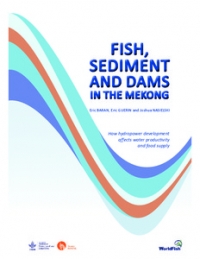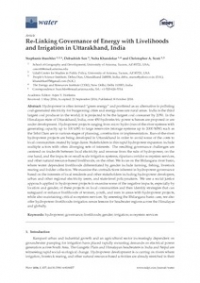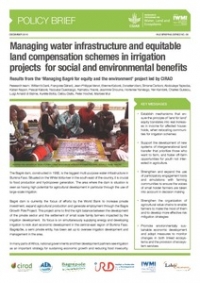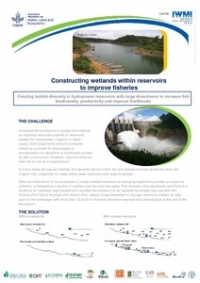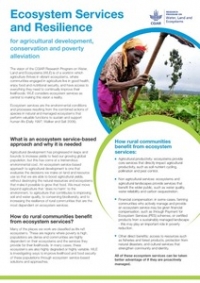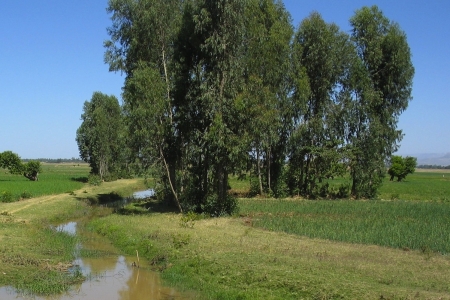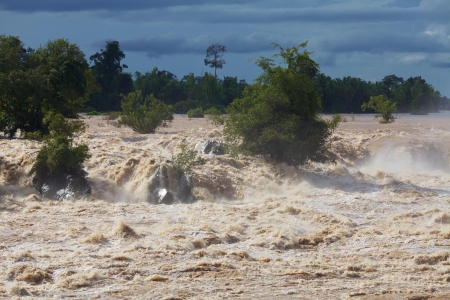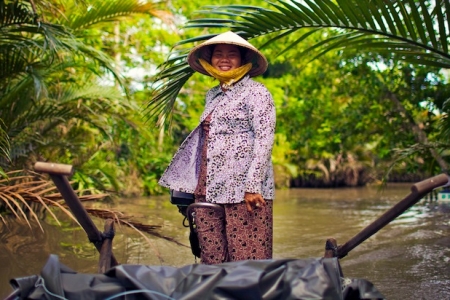Dams provide numerous economic benefits and can mitigate the adverse impacts of water variability and extreme climate events. However, such large-scale water infrastructure has also caused significant social and environmental costs, prompting calls for alternative, nature-based solutions. WLE suggests that collections of built and natural infrastructure, combined with participatory management approaches, can support water and food security, while enhancing livelihoods and environmental outcomes.
Recommendations
- Treat water resources systems as interlinked collections of human-built and natural structures: Planning and managing river basins as suites of complementary natural and built infrastructure can improve benefits, such as reservoir fisheries, recession agriculture, floodplain grazing, flood protection and hydroelectricity production.
- Manage built water structures, such as reservoirs, as aquatic habitat, interconnected with the surrounding landscape: Managing reservoirs as ecosystems can improve habitat diversity, increase fisheries productivity and improve livelihoods, while mitigating adverse human health impacts.
- Invest in natural infrastructure: Natural structures, such as wetlands and floodplains, perform important water resources management functions and can improve the performance of built infrastructure by regulating river flow and reducing erosion and sediment deposition in downstream reservoirs.
Introduction
The ability to store and regulate water is crucial for achieving economic growth, alleviating poverty, supporting food security aims and adapting to climate change. Built structures, such as dams, can negate otherwise naturally occurring consecutive peaks and lows in water availability and provide a reliable supply of water for irrigation, industrial and domestic purposes as well as hydroelectricity at times when it would not naturally be available. It is widely acknowledged that built infrastructure has a vital role to play in climate change adaptation.[1]
Dams are also a major modifier of landscapes and ecosystems. Their construction can require the resettlement of large numbers of people and can dramatically alter ecosystem services on which local communities, especially poor and marginalized members, depend. Key ecosystem services that tend to be adversely affected as a result of dam construction include fisheries, floodplain agriculture and sediment transport.[2] Trade-offs between the benefits that large water infrastructure provides and degrades have spurred a discussion on the need for more built infrastructure versus greater reliance on natural infrastructure, such as wetlands and floodplains, to manage water resources and minimize local and downstream impacts.
Research by WLE scientists and partners points to a new approach to infrastructure design and management—one that considers water resources systems as interconnected collections of built and natural structures. When combined with active local community involvement in decision making and benefit-sharing schemes, this approach has potential to reap important social, economic and environmental benefits.
Benefits and costs of built infrastructure
In 2016, hydroelectricity accounted for nearly 17% of the world’s total electricity generation and for 70% of renewable energy.[3] Moreover, large dams support 30-40% of irrigated areas worldwide, or 12-16% of world food production.[4] Large-scale infrastructure also plays a significant role in reducing flood and drought risks. For the agricultural sector—which absorbs 84% of the adverse economic impacts from droughts and 25% of all damage from climate-related disasters—the potential benefits from mitigating water variability are substantial, as much as USD 94 billion for a single year.[5] [6]
However, the construction of large dams also comes with significant costs. Globally, between 40 and 80 million people have been displaced as a consequence of reservoir inundation. Historically, resettlement programs have been inadequate and most of these people are worse off than they were prior to being resettled. In addition, the livelihoods of an estimated 472 million people living downstream of dams have been adversely affected by changes in flow regimes.[1] All too often the benefits that dams bring, such as regular supplies of electricity and water, do not translate into improved incomes or direct benefits for local people.
Ecosystem degradation and loss of ecosystem services are often underestimated in traditional cost-benefit analyses, but can have dire consequences for both the environment and the communities that depend on them. In the Mekong River basin, dam construction has increased substantially (Box 1). While the economic benefits are significant (e.g., the estimated hydropower potential in the Mekong Basin is 53,000 megawatts), changes in the water, sediment and nutrient fluxes could significantly affect aquatic ecosystems and fish production. According to the International Centre for Environmental Management,[7] the development of 11 hydropower dams on the Mekong mainstream could result in an annual loss of up to 880,000 tons of fish by 2030 compared to the 2000 baseline—a loss worth several hundred million US dollars.[8] [9] Dam construction and climate change are also expected to result in reductions of sediment deposition (53-59%), nutrient inputs (47-84%) and average net primary production of Mekong floodplains (30-38%).[10] These impacts will disproportionally affect communities living alongside the river.[11]
Box 1: Mapping the dams of Southeast Asia
WLE Greater Mekong maintains the most comprehensive dataset on existing and planned dams in the Greater Mekong subregion. Currently the Mekong Hydropower Map and Portal database includes information on 750 dams that are completed, planned or under construction. The database and supporting maps cover the Mekong, Red, Irrawaddy and Salween basins. To better understand the potential impacts from prospective dams in these basins, WLE has also contributed to a Dam Inundation Mapping Tool to model the inundation areas of prospective dams on the Irrawaddy, Salween, Mekong and Red River basins.
Resettlement programs may provide compensation for affected households, but reconstructing livelihood opportunities can be very difficult. Impact assessments of resettlement programs conducted after communities have been resettled due to hydropower dam construction in Lao PDR reveal the importance of maintaining access to fisheries, grazing areas and farmland to sustain livelihoods and incomes. Loss of riverbank gardens and overall changes in the water and aquatic and terrestrial ecosystems immediately following the dam construction can result in both reduced and less diversified household incomes for affected communities (see, e.g., Kura et al. 2014[12]). Dams may also adversely affect public health. For example, WLE research has shown that by providing breeding habitat for anopheles mosquitoes, 1,268 large dams in sub-Saharan Africa elevate the risk of malaria for 15 million people and cause at least 1.1 million people to contract the disease each year (Kibret et al. 2015). If mitigation measures are not improved, these numbers could triple by the end of the century as a result of population growth in combination with climate change–without even considering effects of new dam construction.[13] Small dams and irrigation schemes also increase malaria risk, but to date no systematic analyses of the cumulative impact exists.
The World Commission on Dams (WCD 2000) concluded that large dams should be a development opportunity for all, not a privileged few. New ways of conceptualizing and managing water resource systems can help achieve more sustainable and equitable outcomes. One way of achieving this is to treat river basins as interconnected systems of built (e.g., dams) and natural (e.g., wetlands and floodplains) infrastructure.
River basins as suites of complementary natural and built infrastructure
While large-scale infrastructure is an important aspect of economic development, natural systems are integral to water resources planning and management. Placing a greater emphasis on the role of natural systems means considering them to be ‘infrastructure’ and, conversely, considering built infrastructure to be ‘novel ecosystems’ (Box 2). Through the WISE-UP to Climate project, led by the International Union for Conservation of Nature (IUCN), WLE scientists are contributing to new concepts and approaches that combine built and natural infrastructure for water and food security.
Box 2: Built and natural infrastructure
Built infrastructure (e.g., dams and reservoirs) creates new configurations of biotic and abiotic elements that interact with the landscape in which they are located, and they can be perceived as ‘novel ecosystems.’[14] These are complex, dynamic aquatic ecosystems and there is potential to direct their evolution to provide a suite of desired ecosystem services.[15]
Ecosystems (e.g., wetlands and floodplains) in many respects function like human-built infrastructure. These can be perceived as ‘natural infrastructure’ that, like built structures, perform desired water resources management functions.[16]
Treating water resources systems, like river basins, as interlinked combinations of natural and human-built structures can bring nature to the fore and facilitate improved planning and management of water for increased resilience and sustainability. Planners and investors can then consider different ‘collections’ of built and natural infrastructure and direct their development projects so that they jointly contribute to a suite of desired benefits, such as water for productive uses, recession agriculture, flood protection and production of hydroelectricity, floodplain grazing, and river and reservoir fisheries.
Within this construct, it is important to consider the interconnections between ecosystem services and both built and natural infrastructure. To do this, WLE researchers have classified two types of water-related ecosystem services. Type 1 are those ecosystem services that affect the technical performance (i.e., reliability, resilience and vulnerability) of built infrastructure and hence its ability to deliver the benefits for which it was built (e.g., hydropower and/or irrigation). Type 2 are those that are affected by the physical presence of built infrastructure or by changes in water, sediment or nutrient fluxes caused by the way built infrastructure is designed and operated (e.g., fisheries and/or floodplain agriculture) (Fig. 1).
Fig. 1: Conceptualization of Type 1 and Type 2 ecosystem services[17]
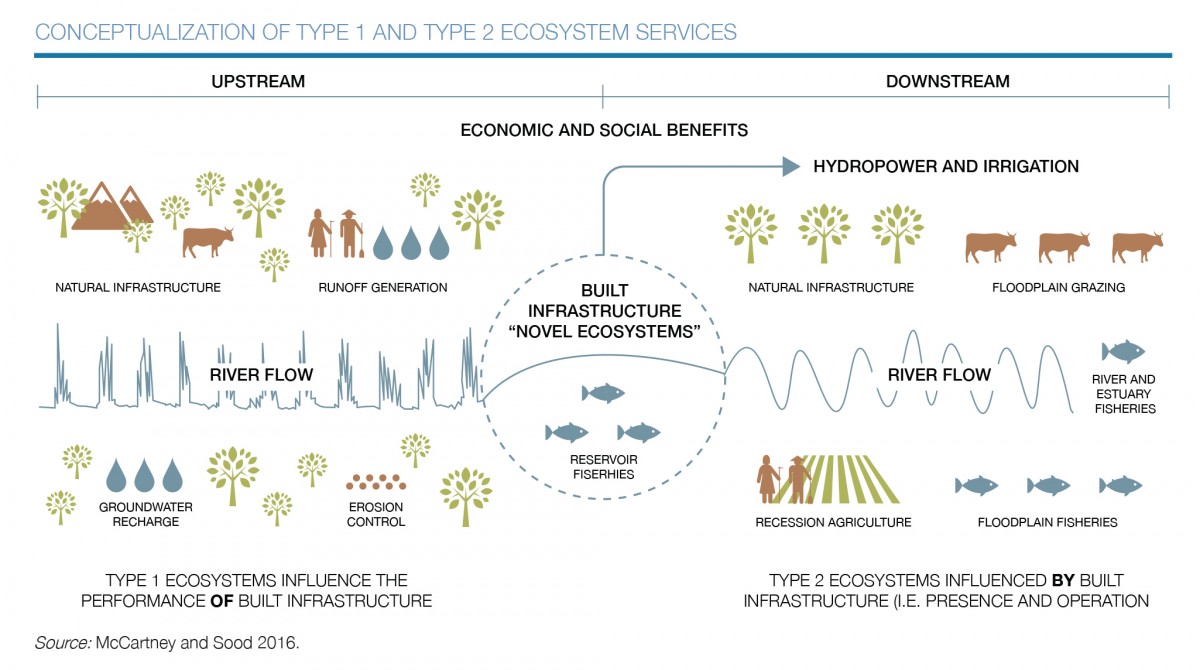
WLE research on managing reservoirs as ecosystems contributes to this concept by investigating how managing reservoirs as ‘novel ecosystems’ can create habitat diversity, increase fisheries productivity, mitigate adverse human health impacts and improve livelihoods.
An ecosystem framework for managing built and natural infrastructure
Ecosystem management seeks to strike a balance between the generation of benefits from built infrastructure and maintaining the ability of ecosystems to sustainably provide ecosystem services. Considering a reservoir as an aquatic habitat, interconnected with the surrounding landscape, rather than simply an inert body of water, promotes the idea that beneficial ecosystem functions can be sustained and enhanced, if carefully managed. Examples from research carried out in Southeast Asia illustrate how this approach can be applied in practice.
Sustaining reservoir fisheries
Hydropower reservoirs are typically characterized by deep, standing or slow flowing water, and drawdown, which occurs when water levels drop due to hydroelectric production, exposes barren banks that contribute little to aquatic productivity. Consequently, reservoirs are often less productive than natural environments. Moreover, the construction of reservoirs rarely offsets the loss of river fisheries and wetland habitats on which especially women and resource-poor households depend for food and nutrition security. Fisheries can be enhanced, however, through the creation of wetlands on the drawdown zones of reservoirs (Fig. 2).
Fig. 2: Creation of wetlands in the drawdown zones of reservoirs to support ecosystems functions.[18]
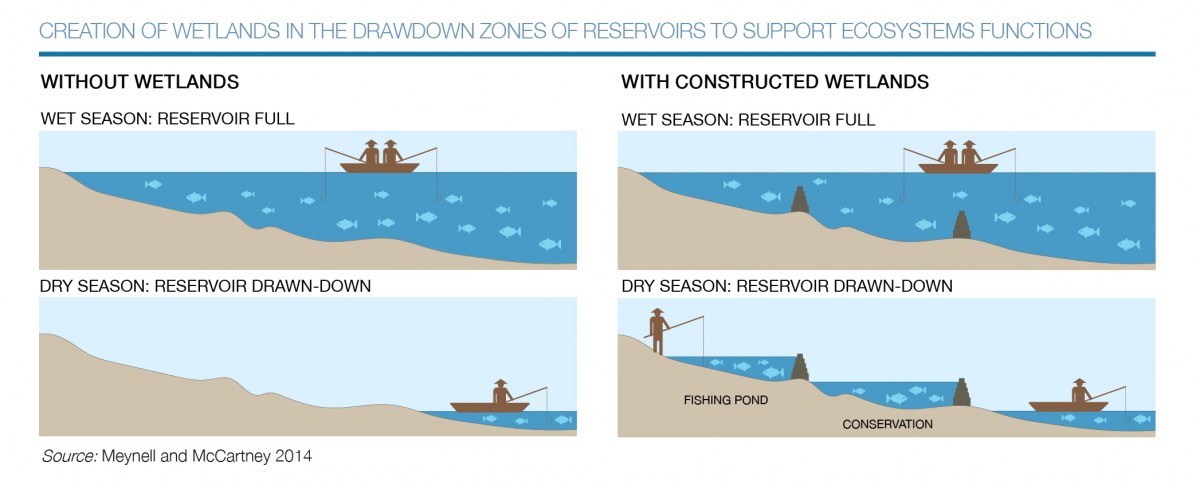
WLE researchers explored the viability of reservoir wetlands, through the construction of earth dykes with a spillway, in Lao PDR’s Nam Gnouang reservoir. Preliminary research indicated that non-intensive fish production in the two proposed wetlands could yield over 500 kg per ha per year. Contributions to local livelihoods could be in the form of a fish conservation area, with the fish that return to the reservoir increasing overall fish stocks, or directly as a source of food, which adds to dietary diversity and are vital sources of nutrition in households that otherwise depend primarily on rice as a food staple. The latter would directly benefit women, who are not active fishers in the main reservoir, but do collect fish and other aquatic organisms from paddy fields and close to the shore.[15]
Protecting recession agriculture
The drawdown zone can additionally provide important agricultural opportunities, particularly in instances where there is limited arable land for farming communities that been relocated due to dam construction. In Vietnam, the 720 megawatt Yali hydropower dam, built on the Sesan River in 2003, resulted in the resettlement of around 1,150 households, and the loss of 1,240 ha of farmland. It also created a fertile drawdown zone of about 2,600 ha, within an elevation of 512-515 m. Pilot studies were conducted to adapt local farmers’ cultivation practices to suit the flooding regime in the drawdown zone, for example by replacing maize with fast-growing cassava varieties. This strategy has resulted in increased crop yields and incomes for participating households with no adverse impacts for electricity generation.[19]
Redesigning fish passages
Dams often block migratory routes that fish use to travel up and down stream. Fish passages are intended to maintain the connectivity of upstream tributaries, the reservoir and the downstream river. In recent years, near-natural fish passages (or bypasses), which mimic the natural condition of a river, have been constructed around reservoirs on selected rivers in Europe, South and North America. Similar bypass channels are now being considered for some dams in the Mekong River basin, including the Lower Sesan 2 in Cambodia. The Lower Sesan 2 Dam has been identified as potentially having the greatest adverse impact on fish production and biodiversity in the Lower Mekong Basin, with an estimated 9.3% reduction of the migratory fish biomass basinwide.[20] WLE has conducted research on the feasibility of passages that simulate natural conditions.[21] The study found nature-based fish passages to be a viable option in this context and has recommended their construction.[15]
Managing dams in sub-Saharan Africa to mitigate malaria risks
Recognizing reservoirs as ecosystems helps identify innovative ways to mitigate adverse health impacts. For example, dams can be operated to disrupt mosquito-breeding sites. Research on the Koka reservoir in Ethiopia determined the potential of manipulating water levels in the reservoir in such a way that it became less suited to the development of malaria transmitting mosquitoes.[22] Computer modelling confirmed that targeted implementation of this approach would have negligible impact on other dam objectives of hydropower and irrigation.[23]
Investing in natural infrastructure to safeguard the performance of built infrastructure
In the Kenya, the Nairobi Water Fund is investing in natural infrastructure in the Tana River to reduce erosion and sediment deposition in downstream reservoirs. Analyses indicate that USD 10 million spent on natural infrastructure in the upper basin (i.e., buffer strips along riverbanks, terracing, reforestation, agroforestry and measures to prevent road erosion) can bring returns of USD 21 million over 30 years through increased hydropower generation and reduced water treatment costs.[24] Benefits are maintained under a range of possible future climate scenarios.[25]
INVOLVEMENT OF LOCAL COMMUNITIES
Infrastructure projects often include resettlement action plans, which provide compensation or asset substitution for affected households. However, it can be difficult to estimate who will actually benefit, and how, in advance of the resettlement. Understanding nuances in livelihoods, land and water use as well as the determinants of adaptation, and using this information as a basis for negotiating fair and equitable deals with communities, is critical for providing viable livelihood opportunities.
The notion of benefit sharing has evolved from that of compensation to a situation in which local people directly and substantially benefit from infrastructure projects. A benefits-sharing partnership enables the local population to have ownership over the project and to strive for more socially just project outcomes for villagers.[26] Involving local communities in the decision making on, and development of, appropriate compensation packages can help ensure that the needs of smallholder farmers are taken into account. Nepal’s run-of-the-river Andhikhola hydropower project offers an example of how a well-designed, multi-purpose project that incorporates the needs of local communities can offer wide-ranging benefits.
While similar examples exist elsewhere, in general, the benefits from hydropower projects continue to be skewed in favor of urban populations. Strengthening and expanding the use of participatory engagement tools with farming communities can help overcome this imbalance and ensure that the voices of smallholder farmers are taken into account in decision making. The use of participatory tools and simulations is one means to foster an exchange of views among stakeholders and develop relations between actors that normally do not interact with each other. This was the conclusion from a recent WLE project in Burkina Faso’s Bagre Dam region, where a role-playing game—jointly designed by researchers, irrigation and water management agencies—allowed a diverse set of actors to collectively discuss, design and practice adaptation strategies in a virtual ‘game’ environment.[27] Read more.
CONCLUSION
Dams are renowned both for the positive changes they bring about, such as flood control, irrigation and hydropower, and for their negative impacts, including displacement of people, changes in water and sediment flows, and disruption to environmental services and livelihoods.
The solution to this dichotomy is not to forego investment in built infrastructure, which remains essential for socio-economic development, but to give greater consideration to the role of nature in planning and operating large, built infrastructure. Conceptualizing water resource systems as collections of natural and built infrastructure operating synergistically can present options to reduce negative impacts and achieve more equitable and sustainable outcomes. Research shows, for example, that reservoirs can be designed and managed to create better fish habitats, and farmers can be supported to adapt farming techniques to new flooding regimes. These environmental services and livelihoods benefits can be achieved without compromising energy generation. WLE will continue its research on the combined role of natural and built infrastructure to support water and food security, reduce floods and droughts, and enhance environmental and equitable outcomes.
Reservoirs can also be controlled to disrupt mosquito breeding and thereby reduce the spread of malaria. WLE will carry out a systematic analysis of impacts and risks of malaria from small reservoirs and irrigation schemes in the coming phase of work. Finally, natural and agricultural systems can be managed to reduce sedimentation of reservoirs. Combining such approaches with an understanding of local livelihoods and utilizing participatory approaches to negotiate outcomes will maximize benefits.
Acknowledgements
The team acknowledges the contributions and efforts of Meredith Giordano (Principal Researcher, IWMI), Douglas Merrey (independent consultant), and Alexandra Evans (independent consultant) in preparing the content for this series; and Caroline Holo (intern), Miles Bell (intern) and Aishwarya Venkat (intern) for their assistance with literature and data collection. We would also like to acknowledge the support of WLE scientists and partners in the preparation and review of the briefs. This research was supported by CGIAR Fund Donors.
References
-
1.
McCartney, M.P.; Smakhtin, V. 2010. Water storage in an era of climate change: Addressing the challenge of increasing rainfall variability. Blue paper. Colombo, Sri Lanka: International Water Management Institute (IWMI). 14p.
-
2.
WCD (World Commission on Dams). 2000. Dams and development: A new framework for decision-making. London, UK and Sterling, VA, USA: Earthscan. Available at https://awsassets.panda.org/downloads/wcd_dams_final_report.pdf (accessed on April 19, 2017).
-
3.
REN21 (Renewable Energy Policy Network for the 21st Century). 2016. Renewables 2016: Global status report. Paris, France: REN21 Secretariat.
-
4.
FAO (Food and Agriculture Organization of the United Nations). 2007. Dams and agriculture in Africa. Prepared by the AQUASTAT programme. Rome, Italy: FAO. 14p. (accessed on April 19, 2017).
-
5.
FAO. 2015. The impact of natural hazards and disasters on agriculture and food security and nutrition: A call for action to build resilient livelihoods. Rome, Italy: FAO. 15p. Available at https://www.fao.org/3/a-i4434e.pdf (accessed on April 19, 2017).
-
6.
Sadoff, C.W.; Hall, J.W.; Grey, D.; Aerts, J.C.J.H.; Ait-Kadi, M.; Brown, C.; Cox, A.; Dadson, S.; Garrick, D.; Kelman, J.; McCornick, P.; Ringler, C.; Rosegrant, M.; Whittington, D.; Wiberg, D. 2015. Securing water, sustaining growth: Report of the GWP/OECD Task Force on Water Security and Sustainable Growth. Oxford, UK: University of Oxford. 180p.
-
7.
ICEM (International Centre for Environmental Management). 2010. Mekong River Commission strategic environmental assessment of hydropower on the Mekong mainstream. Hanoi, Vietnam: ICEM. 145p.
-
8.
Nam, S.; Phommakone, S.; Vuthy, L.; Samphawamana, T.; Hai Son, N.; Khumsri, M.; Peng Bun, N.; Sovanara, K.; Degen, P.; Starr, P. 2015. Economic value of Lower Mekong fisheries: Lower Mekong fisheries estimated to be worth around $17 billion a year. Catch and Culture 21(3): 4-7.
-
9.
Mille, G.; Hap, N.; Loeng, N. 2016. Economic value of fish in Cambodia and value added along the trade chain. Phnom Penh, Cambodia: Inland Fisheries Research and Development Institute (Fisheries Administration) and WorldFish. 62p.
-
10.
Baran, E.; Guerin, E.; Nasielski, J. 2015. Fish, sediment and dams in the Mekong. Penang, Malaysia: WorldFish; and CGIAR Research Program on Water, Land and Ecosystems (WLE). 108p.
-
11.
Katus, S.; Suhardiman, D.; Senaratna Sellamuttu, S. 2016. When local power meets hydropower: Reconceptualizing resettlement along the Nam Gnouang River in Laos. Geoforum 72: 6-15.
-
12.
Kura, Y.; Joffre, O.; Laplante, B.; Sengvilaykham, B. 2014. Redistribution of water use and benefits among hydropower affected communities in Lao PDR. Water Resources and Rural Development 4(C): 67-84.
-
13.
Kibret, S.; Lautze, J.; McCartney, M.; Nhamo, L.; Glenn Wilson, G. 2016. Malaria and large dams in sub-Saharan Africa: Future impacts in a changing climate. Malaria Journal 15: 448.
-
14.
Hobbs, R.J.; Arico, S.; Aronson, J.; Baron, J.S.; Bridgewater, P.; Cramer, V.A.; Epstein, P.R.; Ewel, J.J.; Klink, C.A.; Lugo, A.E.; Norton, D.; Ojima, D.; Richardson D.M.; Sanderson, E.W.; Valladares, F.; Vilà, M.; Zamora, R.; Zobel, M. 2006. Novel ecosystems: Theoretical and management aspects of the new ecological world order. Global Ecology and Biogeography 15: 1-7.
-
15.
McCartney, M.P.; Kura, Y.; Meynell, P.; Senaratna Sellamuttu, S.; Matthews, N. 2016. Hydropower reservoirs as novel ecosystem: Adopting an ecosystems based approach for management. Proceedings of the Sixth International Conference and Exhibition on Water Resources and Hydropower Development in Asia, Vientiane, Lao PDR, March 1-3, 2016. Wallington, UK: The International Journal on Hydropower & Dams.
-
16.
Emerton, L.; Bos, E. 2004. Value - Counting ecosystems as an economic part of water infrastructure. Gland, Switzerland and Cambridge, UK: International Union for Conservation of Nature (IUCN). 88p.
-
17.
McCartney, M.P.; Sood, A. 2016. Understanding the link to water and quantifying Ecosystem Services in the Tana Basin, Kenya. Ecosystem Services Partnership Conference, 21-25 November, Nairobi, Kenya.
-
18.
Meynell, P.; McCartney, M. 2014. Constructing wetlands within reservoirs to improve fisheries. Colombo, Sri Lanka: International Water Management Institute (IWMI). CGIAR Research Program on Water, Land and Ecosystems (WLE). 2p. Available at https://cgspace.cgiar.org/handle/10568/35099 (accessed on April 19, 2017).
-
19.
Sellamuttu, S.S.; Phuong, N.D.; Bouahom, B.; Joffre, O.; Pant, J.; Keophoxay, A. 2014. Hydropower development and livelihoods: a quest for a balanced approach through research and partnerships. In: Aqua-Media International. Fifth International Conference on Water Resources and Hydropower Development in Asia, Colombo, Sri Lanka, 11-13 March 2014. Wallington, Surrey, UK: Aqua-Media International. 9p.
-
20.
Ziv, G.; Baran, E.; Nam, S.; Rodríguez-Iturbe, I.; Levin, S.A. 2012. Trading-off fish biodiversity, food security, and hydropower in the Mekong River Basin. Proceedings of the National Academy of Sciences 109(15): 5609-5614.
-
21.
Gätke, P.; Baran, E.; Fontes Jr, H.M.; Makrakis, S.; Makrakis, M.C.; Räsänen, T.A.; Saray, S. 2014. Fish passage opportunities for the Lower Sesan 2 Dam in Cambodia - lessons from South America. Chapter 3.2 in: On optimizing the management of cascades or system of reservoirs at catchment level. Hanoi, Vietnam: International Centre for Environmental Management (ICEM). 27p. Available at https://www.optimisingcascades.org/wp-content/uploads/2014/03/FE-4.-Fish-passage-opportunities.pdf (accessed on April 19, 2017).
-
22.
Kibret, S.; Lautze, J.; Boelee, E.; McCartney, M. 2012. How does an Ethiopian dam increase malaria? Entomological determinants around the Koka reservoir. Tropical Medicine & International Health 17(11): 1320-1328.
-
23.
Reis, J.; Culver, T.; McCartney, M.; Lautze, J.; Kibret, S. 2011. Water resources implications of integrating malaria control into the operation of an Ethiopian dam. Water Resources Research 47(9): W09530. doi:10.1029/2010WR010166.
-
24.
TNC (The Nature Conservancy). 2015. Upper Tana-Nairobi Water Fund Business Case. Version 2. Nairobi, Kenya: TNC.
-
25.
Simons, G.; Buitink, J.; Droogers, P.; Hunink, J. 2017. Impacts of climate change on water and sediment flows in the Upper Tana Basin, Kenya. FutureWater Report 161. Wageningen, Netherlands: FutureWater.
-
26.
Buechler, S.; Sen, D.; Khandekar, N.; Scott, C.A. 2016. Re-linking governance of energy with livelihoods and irrigation in Uttarakhand, India. Water 8(10): 437.
-
27.
Daré, W.; Gérard, F.; Venot, J-P.; Kaboré, E.; Idani, D.; Carboni, S.; Tapsoba, A.; Napon, K.; Kaboré, P.; Ouedraogo, Y.; Traoré, R.; Gnouma, J.; Yaméogo, H.; Kambiré, Y.; Guissou, C.; Arnaldi di Balme, L.; Botta, A.; Diallo, C.; Hochet, P.; Mul, M. 2016. Managing water infrastructure and equitable land compensation schemes in irrigation projects for social and environmental benefits. Colombo, Sri Lanka: International Water Management Institute (IWMI). CGIAR Research Program on Water, Land and Ecosystems (WLE). 4p. (WLE Briefing Series No. 8).
Further reading
Eguavoen, I.; McCartney, M. 2013. Water storage: a contribution to climate change adaptation in Africa Rural 21, 47(1): 38-41.
CGIAR Research Program on Water, Land and Ecosystems. 2015. Reconstructing wetlands in the Mekong
CGIAR Research Program on Water, Land and Ecosystems. 2014. Big Questions: Should we build more large dams?
Daré, W.; Gérard, F.; Venot, J-P.; Kaboré, E.; Idani, D.; Carboni, S.; Tapsoba, A.; Napon, K. ; Kaboré, P.; Ouedraogo, Y.; Traoré, R.; Gnouma, J.; Yaméogo, H.; Kambiré, Y.; Guissou, C.; Arnaldi di Balme, L.; Botta, A.; Diallo, C.; Hochet, P.; Mul, M.; 2016. Managing water infrastructure and equitable land compensation schemes in irrigation projects for social and environmental benefits. Colombo, Sri Lanka: International Water Management Institute (IWMI).CGIAR Research Program on Water, Land and Ecosystems (WLE).4p.WLE BRIEFING SERIES NO. 08 (accessed April 17, 2017).
CGIAR Research Program on Water, Land and Ecosystems (WLE). 2016. Gender and ethnic dynamics of household decision making in hydropower-related resettlement. Colombo, Sri Lanka: CGIAR Research Program on Water, Land and Ecosystems (WLE). 4p. (WLE Briefing Series 07)
Grafton, R.Q.; McLindin, M.; Hussey, K.; Wyrwoll, P.; Wichelns, D.; Ringler, C.; Garrick, D.; Pittock, J.; Wheeler, S.; Orr, S.; Matthews, N.; Ansink, E.; Aureli, A.; Connell, D.; De Stefano, L.; Dowsley, K.; Farolfi, S.; Hall, J.; Katic, P.; Lankford, B.; Leckie, H.; McCartney, M.; Pohlner, H.; Ratna, N.; Rubarenzya, M.H.; Raman, S.N.S.; Wheeler, K.; Williams, J. 2016. Responding to global challenges in food, energy, environment and water: Risks and options assessment for decision-making. Asia and the Pacific Policy Studies 3(2): 275-299. doi: 10.1002/app5.128
Lacombe, G.; McCartney, M. 2016. Evaluating the flow regulating effects of ecosystems in the Mekong and Volta river basins. Colombo, Sri Lanka: International Water Management Institute (IWMI). 40p. (IWMI Research Report 166). doi: 10.5337/2016.202
Lacombe G.; Douangsavanh S.; Baker J.; Hoanh C.T.; Bartlett R.; Jeuland M.; Phongpachith, C. 2014. Are hydropower and irrigation development complements or substitutes? The example of the Nam Ngum River in the Mekong Basin. Water International 39(5): 649–670.
McCartney, M.P.; Dalton, J. 2015. Built or natural infrastructure: a false dichotomy.
McCartney, M.; Finlayson, M.; de Silva, S. 2014. Sustainable Development and Ecosystems Services. In: On Target for People and Planet. Setting and Achieving Water – related Sustainable Development Goals, (eds.), Van der Bliek, J.; McCornick, P.; Clarke, J. Colombo, Sri Lanka: International Water Management Institute (IWMI). Pp. 28-32.
McCartney, M.; Finlayson, M.; de Silva, S. 2015. Sustainable development and ecosystem services. New York, NY, USA: United Nations Department of Economic and Social Affairs. 4p. (Global Sustainable Development Report Brief (GSDR)).
McCartney, M.; Cai, X.; Smakhtin, V. 2013. Evaluating the flow regulating functions of natural ecosystems in the Zambezi River Basin. Colombo, Sri Lanka: International Water Management Institute (IWMI). 59p. (IWMI Research Report 148). doi:10.5337/2013.206
McCartney, M.; Johnston, R.; Lacombe, G. 2016. Building climate resilience through smart water and irrigation management systems. In: Climate change and agricultural development: Improving resilience through climate smart agriculture, agroecology and conservation, (ed.), Nagothu U.S. Oxon, UK: Routledge. Pp.41-65.
Meynell, P. 2014. Improving reservoir ecology with constructed wetlands. Hydropower and Dams, Issue 3. ICEM (International Centre for Environment Management).
Orr, S. 2013. Dams on the Mekong, 151–155.
Orr, S. 2013. Dams on the Mekong. Global Water Forum, Canberra, Australia. (GWF Discussion Paper 1302) (accessed on April 19, 2017).
Reis, J.; Culver, T.B.; Lacombe, G.; Senaratna Sellamutu, S. 2014. Reservoir operation for recession agriculture in Mekong Basin, Laos. Journal of Water Resources Planning and Management 141(7): 1–9.
Ringler, C.; Bhaduri, A.; Lawford, R. 2013. The nexus across water, energy, land and food (WELF): potential for improved resource use efficiency? Current Opinion in Environmental Sustainability 5(6): 617-624.
Sayatham, M.; Suhardiman, D. (2015). Hydropower resettlement and livelihood adaptation: The Nam Mang 3 project in Laos. Water Resources and Rural Development 5: 17–30. https://doi.org/10.1016/j.wrr.2015.01.001
Senaratna Sellamuttu, S.; Phuong, N.D.; Bouahom, B.; Joffre, O.; Pant, J.; Keophoxay, A. 2014. Hydropower development and livelihoods: a quest for a balanced approach through research and partnerships. Proceedings of the Fifth International Conference on Water Resources and Hydropower Development in Asia. Colombo, Sri Lanka, 11-13 March 2014. Wallington, Surrey, UK: Aqua-Media International. 9p.
Shah, T.; Sadoff, C.; McCornick, P.; Molle, F.; Samad, M.; Suhardiman, D.; van Koppen, B. 2014. Water Governance: Context is Crucial. In: On Target for People and Planet. Setting and Achieving Water – related Sustainable Development Goals, 52, (eds.) Van der Bliek, J.; McCornick, P.; Clarke, J. Colombo, Sri Lanka: International Water Management Institute.
Smakhtin, V.; Amarnath, G.; McCartney, M.; Campbell, B. 2014. Managing Water Variability: Floods and Droughts. In: On Target for People and Planet. Setting and Achieving Water – related Sustainable Development Goals, 52, (eds.) Van der Bliek, J.; McCornick, P.; Clarke, J. Colombo, Sri Lanka: International Water Management Institute.
Suhardiman, D.; Wichelns, D.; Lebel, L.; Sellamuttu, S.S. 2014. Benefit sharing in Mekong Region hydropower: Whose benefits count? Water Resources and Rural Development 4: 3–11. https://doi.org/10.1016/j.wrr.2014.10.008
McCartney, M.; Mounphoxay, S.; Hendersen, D. 2016. Getting the Balance Right.
Weeratunge, N; Joffre, O.; Senaratna Sellamuttu, S; Bouahom, B.; Keophoxay, A. 2016. Gender and household decision-making in a Lao Village: implications for livelihoods in hydropower development. Gender, Place & Culture 23(11): 1599-1614.
Winemiller, K.O.; McIntyre, P.B.; Castello, L.; Fluet-Chouinard, E.; Giarrizzo, T.; Nam, E.; Baird, I.G.; Darwall, W.; Lujan, N.K.; Harrison, I.; Stiassny, M.L.J.; Silvano, R.A.M.; Fitzgerald, D.B.; Pelicice, F.M.; Agostinho, A.A.; Gomes, L.C.; Albert, J.S.; Baran, E.; Petrere Jr., M.; Zarfl, C.; Mulligan, M.; Sullivan, J.P.; Arantes, C.C.; Sousa, L.M.; Koning, A.A.; Hoeinghaus, D.J.; Sabaj, M.; Lundberg, J.G.; Armbruster, J.; Thieme, M.L.; Petry, P.; Zuanon, J.; Torrente Vilara, G.; Snoeks, J.; Ou, C.; Rainboth, W.; Pavanelli, C.S.; Akama, A.; van Soesbergen, A.; Sáenz, L. 2016. Balancing hydropower and biodiversity in the Amazon, Congo, and Mekong. Science 351(6269): 128–129.
WISE-UP [WISE-UP to Climate Change Project]. 2014. Concept note on ecosystem services mapping and linkages to models.
Zeng, R.; Cai, X.; Ringler C.; and Zhu, T. 2017. Hydropower versus irrigation – An analysis of global patterns. Environmental Research Letters 12: 034006. Available at https://doi.org/10.1088/1748-9326/aa5f3f (accessed April 19, 2017).

